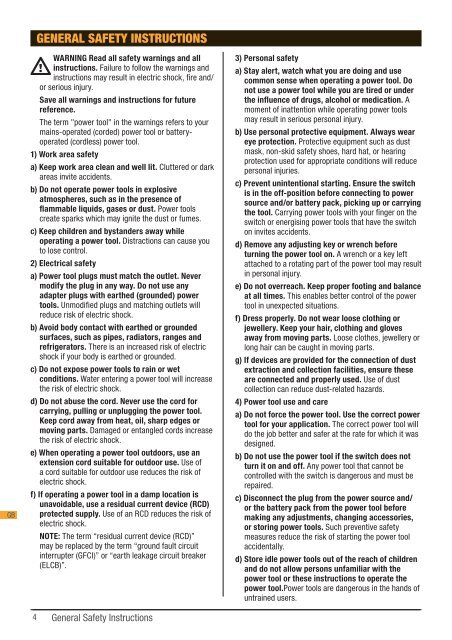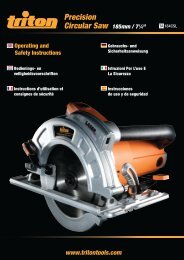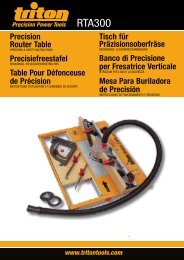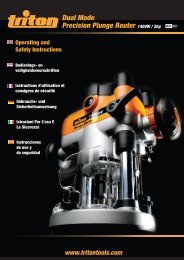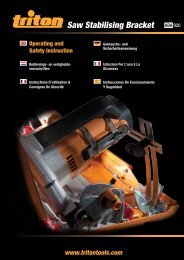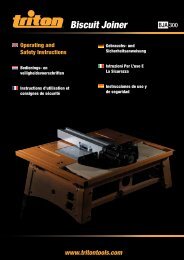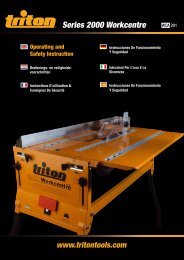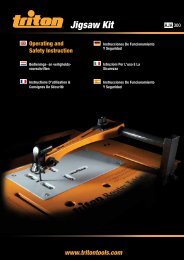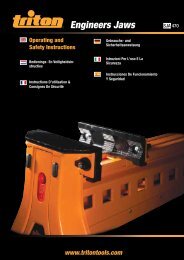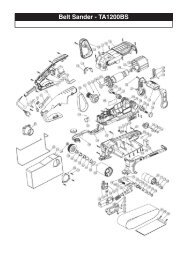Manual de instrucciones - Triton Tools
Manual de instrucciones - Triton Tools
Manual de instrucciones - Triton Tools
You also want an ePaper? Increase the reach of your titles
YUMPU automatically turns print PDFs into web optimized ePapers that Google loves.
GB<br />
GENERAL SAFETY INSTRUCTIONS<br />
WARNING Read all safety warnings and all<br />
instructions. Failure to follow the warnings and<br />
instructions may result in electric shock, fire and/<br />
or serious injury.<br />
Save all warnings and instructions for future<br />
reference.<br />
The term "power tool" in the warnings refers to your<br />
mains-operated (cor<strong>de</strong>d) power tool or batteryoperated<br />
(cordless) power tool.<br />
1) Work area safety<br />
a) Keep work area clean and well lit. Cluttered or dark<br />
areas invite acci<strong>de</strong>nts.<br />
b) Do not operate power tools in explosive<br />
atmospheres, such as in the presence of<br />
flammable liquids, gases or dust. Power tools<br />
create sparks which may ignite the dust or fumes.<br />
c) Keep children and bystan<strong>de</strong>rs away while<br />
operating a power tool. Distractions can cause you<br />
to lose control.<br />
2) Electrical safety<br />
a) Power tool plugs must match the outlet. Never<br />
modify the plug in any way. Do not use any<br />
adapter plugs with earthed (groun<strong>de</strong>d) power<br />
tools. Unmodified plugs and matching outlets will<br />
reduce risk of electric shock.<br />
b) Avoid body contact with earthed or groun<strong>de</strong>d<br />
surfaces, such as pipes, radiators, ranges and<br />
refrigerators. There is an increased risk of electric<br />
shock if your body is earthed or groun<strong>de</strong>d.<br />
c) Do not expose power tools to rain or wet<br />
conditions. Water entering a power tool will increase<br />
the risk of electric shock.<br />
d) Do not abuse the cord. Never use the cord for<br />
carrying, pulling or unplugging the power tool.<br />
Keep cord away from heat, oil, sharp edges or<br />
moving parts. Damaged or entangled cords increase<br />
the risk of electric shock.<br />
e) When operating a power tool outdoors, use an<br />
extension cord suitable for outdoor use. Use of<br />
a cord suitable for outdoor use reduces the risk of<br />
electric shock.<br />
f) If operating a power tool in a damp location is<br />
unavoidable, use a residual current <strong>de</strong>vice (RCD)<br />
protected supply. Use of an RCD reduces the risk of<br />
electric shock.<br />
NOTE: The term “residual current <strong>de</strong>vice (RCD)”<br />
may be replaced by the term “ground fault circuit<br />
interrupter (GFCI)” or “earth leakage circuit breaker<br />
(ELCB)”.<br />
3) Personal safety<br />
a) Stay alert, watch what you are doing and use<br />
common sense when operating a power tool. Do<br />
not use a power tool while you are tired or un<strong>de</strong>r<br />
the influence of drugs, alcohol or medication. A<br />
moment of inattention while operating power tools<br />
may result in serious personal injury.<br />
b) Use personal protective equipment. Always wear<br />
eye protection. Protective equipment such as dust<br />
mask, non-skid safety shoes, hard hat, or hearing<br />
protection used for appropriate conditions will reduce<br />
personal injuries.<br />
c) Prevent unintentional starting. Ensure the switch<br />
is in the off-position before connecting to power<br />
source and/or battery pack, picking up or carrying<br />
the tool. Carrying power tools with your finger on the<br />
switch or energising power tools that have the switch<br />
on invites acci<strong>de</strong>nts.<br />
d) Remove any adjusting key or wrench before<br />
turning the power tool on. A wrench or a key left<br />
attached to a rotating part of the power tool may result<br />
in personal injury.<br />
e) Do not overreach. Keep proper footing and balance<br />
at all times. This enables better control of the power<br />
tool in unexpected situations.<br />
f) Dress properly. Do not wear loose clothing or<br />
jewellery. Keep your hair, clothing and gloves<br />
away from moving parts. Loose clothes, jewellery or<br />
long hair can be caught in moving parts.<br />
g) If <strong>de</strong>vices are provi<strong>de</strong>d for the connection of dust<br />
extraction and collection facilities, ensure these<br />
are connected and properly used. Use of dust<br />
collection can reduce dust-related hazards.<br />
4) Power tool use and care<br />
a) Do not force the power tool. Use the correct power<br />
tool for your application. The correct power tool will<br />
do the job better and safer at the rate for which it was<br />
<strong>de</strong>signed.<br />
b) Do not use the power tool if the switch does not<br />
turn it on and off. Any power tool that cannot be<br />
controlled with the switch is dangerous and must be<br />
repaired.<br />
c) Disconnect the plug from the power source and/<br />
or the battery pack from the power tool before<br />
making any adjustments, changing accessories,<br />
or storing power tools. Such preventive safety<br />
measures reduce the risk of starting the power tool<br />
acci<strong>de</strong>ntally.<br />
d) Store idle power tools out of the reach of children<br />
and do not allow persons unfamiliar with the<br />
power tool or these instructions to operate the<br />
power tool.Power tools are dangerous in the hands of<br />
untrained users.<br />
4<br />
General Safety Instructions


